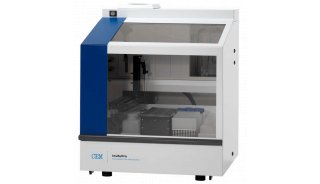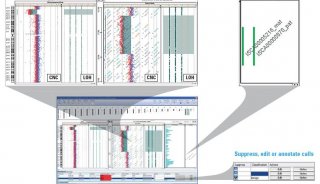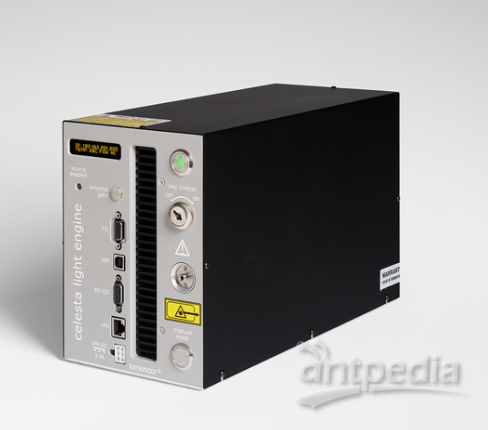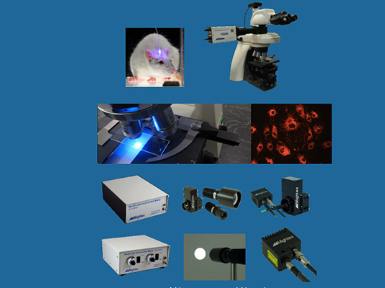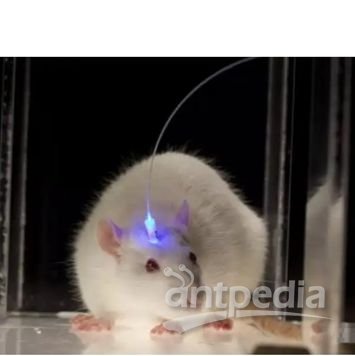细胞遗传学——原位杂交(ISH)
In Situ Hybridization
· In Situ Hybridization (jsmith1@po-box.mcgill.ca)
In situ hybridization, as the name suggests, is a method of localizing, either mRNA within the cytoplasm or DNA within the chromosomes of the nucleus, by hybridizing the sequence of interest to a complimentary strand of a nucleotide probe.
This is a general guide to in situ hybridization technique including the following topics: Preparation of material, probe types and preparation, typical procedure, FISH, In situ PCR & in situ RT-PCR, PRINS, visualization and measurement
· Chromosome Preparation for in situ Hybridization (ISH) (Wheat Genetics Resource Center)
· Tissue Preparation for In Situ Hybridization (Wilcox Lab)
· In Situ Hybridization on Frozen Sections (Wilcox Lab)
· In Situ Hybridizatioin Using Digoxigenin Probes on Tissue Sections (Pfaff Lab)
Procedures for tissue preparation, hybridization, staining, probe labeling
· In Situ Hybridization to Tissue Sections (Vesicle Trafficking)
Protocol in great detail
· Cytochemical Detection of mRNA by in situ hybridization (Childs Lab)
Detailed procedure for detecting messenger ribonucleic acids (mRNAs) in a cell.
· In Situ Hybridisation with DIG-RNA Probes On Embryos (Ilan Davis)
Protocol for fly including probe preparation
· Mouse Whole Mount in situ Hybridization (De Robertis' Lab)
Protocol including probe labeling (Dig), embryo preparation and hybridization
· In Situ Hybridization Using Digoxigenin Labeled Probes (Berkeley Drosophila Genome Project)
Procedures for chromosome squash preparation, probe labeling, hybridization and more...
· 96-Well RNA In Situ Hybridization (Berkeley Drosophila Genome Project)
Protocol for fly including embyro preparation, probe labeling, hybridization in 96-well plate.
· In Situ Hybridization (Wheat Genetics Resource Center)
· RNA in situ protocol for DNA and RNA probes (Carroll Lab)
· mRNA In Situ Hybridization withNick Translated Probes (Spector Lab)
· In Situ Hybridization (Frozen Sections) (Tyner Lab)
Detailed protocol for ISH including slide pretreatment, preparation of frozen sections from tissue, prehybridization of slides, probe preparation, hybridization, radiography, developing, and staining of slides and trouble shooting
In Situ Hybridization (Paraffin Sections) (Tyner Lab)
Detailed protocol for ISH on paraffin embedded tissues including paraffin sectioning, probe preparation and more...
In Situ Hybridization Protocol for Paraffin-embedded Tissues (RHS)
· In Situ Hybridization (William H. Heidcamp)
RNA probe preparation and hybridization for cultured cell
· FISH on Human Chromosomes and Interfase Nuclei
Gives details on slide preparation, plasmid, cosmid and YAC library probe preparation and detection
· The Acrylamide Gel 3-D FISH Protocol (Hank W Bass)
Protocol in great detail
· In Situ Hybridization (Anderson Lab)
These protocols describe non-radioactive methods for in situ hybridization on frozen sections, whole mount embryos and on cultured cells.
· Non-Radioactive In Situ Hybridization Protocol for Plants (Barton Lab)
Including section preparation, in vitro transcription, sin situ hybridization and more...
· In Situ Hybridization (XMMR)
Non-radioactive method for in situ hybridization on mount embryos
· DNA in situ hybridization with streptavidin-Nanogold and silver acetate autometallography (Mag. Heidi Bartel)
This protocol allowed a reliable and very sensitive detection of few copies of human papillomavirus (HPV), cytomegalovirus (CMV), Epstein Barr Virus (EBV), herpes simplex virus (HSV) and other DNA-viruses in routinely formalin-fixed and paraffin-embedded tissues.
· Detection of Human Papillomavirus in Cervical Carcinoma:
Comparison of peroxidase-, Nanogold-, and CARD-Nanogold In Situ Hybridization (Mag. Heidi Bartel)
This protocol allowed a reliable super-sensitive detection of even single copies of human papillomavirus in routinely formalin-fixed and paraffin-embedded tissue specimens as well as on formalin-fixed cytological preparations.
· RNA in situ Hybridization with Catalyzed Reporter Deposition (CARD) Using Biotinylated Tyramide and Streptavidin-Nanogold
This protocol allow a reliable super-sensitive detection of RNA sequences in optimized formalin-fixed and paraffin-embedded tissue specimens as well as on formalin-fixed cytological preparations.
· In situ hybridization of mammalian cells(Singer Lab)
in situ hybridization using RNA and Oligonucleotide probes
· In Situ Hybridization of Yeast Cells Using RNA and Oligonucleotide Probes(Singer Lab)
· Germline In Situ Hybridization (Schedl Lab)
In Situ Hybridization to Dissected Gonads with Digoxygenin-Labeled Probes
· Chromosome In Situ Hybridization Using Biotin Labeled Probes (Carthew Lab)
· In-Situ Hybridization to mRNA using radiolabelled cRNA probes (Beverly Faulkner-Jones)
In situ hybridization (ISH) is the detection of a target DNA or RNA sequence in a tissue section using a labeled nucleic acid probe. It is still the only hybridization technique which allows cellular and subcellular localization of the target.
· Hiro Hirai's BAC-FISH (Schistosoma Genome Network)
This protocol is a modification of the standard FISH protocol published by Hiro Hirai and Phil LoVerde that has been optimized for use with BAC probes. This protocol uses the BIOPRIME reaction kit from GibcoBRL to prepare biotin-labeled BAC DNA which is detected using FITC-Avidin (Vector Labs, DCS grade). Reagents from other manufacturers may work equally well but have not been tested.
· Screening cDNA Clones by RNA In Situ Hybridization (Goodman Laboratory)
The RNA in situ procedure described below is based on the protocol developed by Tautz and Pfeifle, but adapted to allow the screening of 96 RNA probes on whole-mount Drosophila embryos at the same time.
· Single and Double FISH protocols for Drosophila (Krause Lab)
Autoradiography (William H. Heidcamp)
This procedure involves the incorporation of a radioactive substance into a cell, and subsequent detection of that material through the use of a photographic emulsion. The primary source used for cell biology is an organic molecule containing tritium, the radioactive form of hydrogen. Radioactive carbon, phosphorous and iodine are occasionally utilized, but tritium has inherently more resolution than any of the others
Probe Labeling (See also Molecular Biology>DNA>Labeling)
· Probe Selection and Labeling (Jim)
General guide to probe type selection and labeling
Preparation of probes for in situ hybridization (Singer Lab)
DNA oligonucleotide probes,RNA probes and chemical conjugation of the amino-modified nucleic acids with activated fluorophores
Synthesis of Digoxigenenin Labeled Probes (Seydoux Lab)
Preparation of single-stranded probes from cloned cDNA
· Biotin labeling and hybridization of probe to chromosomes (Wheat Genetics Resource Center)
· Preparation and purification of biotin-labeled probe for ISH (Wheat Genetics Resource Center)
· 35S-Riboprobe Synthesis for Isotopic ISH (Wilcox Lab)
· Digoxigenin labelled probe synthesis (Carroll Lab)
· Digoxigenin labelled riboprobe synthesis (Carroll Lab)
· Nick Translation of ds DNA with Biotinylated or Digoxigenin dUTP
For the use with FISH (fluorescent in situ hybridization)
Solutions
· Preparation of Stock Solutions for FISH
Recipes for FISH solutions









